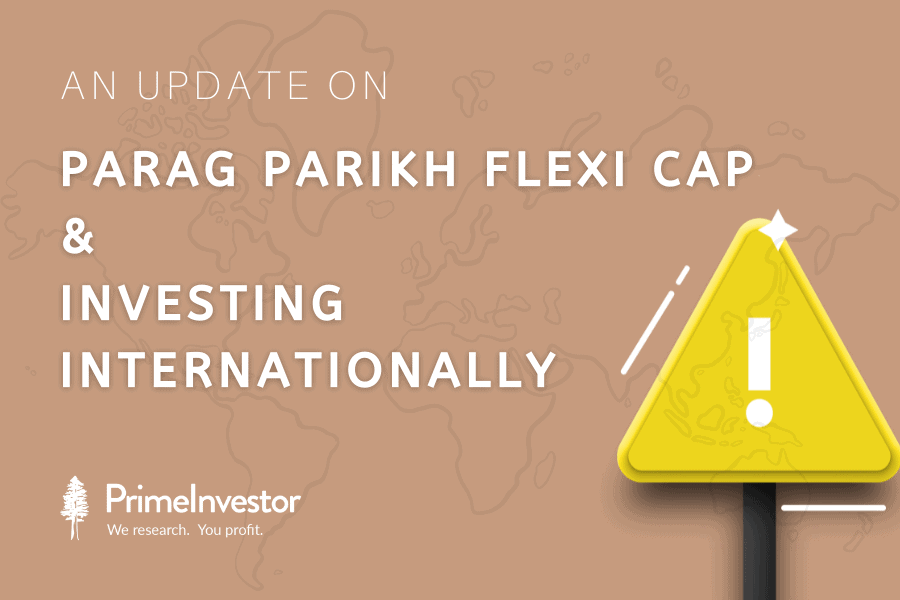In January, mutual funds investing overseas came up to a roadblock. As we had explained at the time on these curbs on international funds, The Reserve Bank of India’s rules limit the amount mutual funds as a whole can invest in foreign securities. The cap stands at $7 billion for all foreign securities other than ETFs and $1 billion for ETFs. That $7 billion mark was close to being breached. And so, SEBI directed international funds to close off fresh subscriptions until a new limit could be worked out with the RBI. Please read our earlier article on this subject to understand the background.
Parag Parikh Flexi Cap – for long part of Prime Funds and some of our Prime Portfolios – also stopped accepting fresh lumpsum investments and new SIP registrations (existing SIPs can continue) in the wake of this SEBI directive. But here’s an update on Parag Parikh Flexi Cap – the fund has now lifted these restrictions and is accepting fresh inflows.
But does this mean that the fund can go back to its original strategy? We have received some queries on this from you, since the update on Parag Parikh Flexi Cap. And on a broader level, with no end in sight for the ban on international investments for funds, what can you do about your investments?

Update on Parag Parikh Flexi Cap
Parag Parikh Flexi Cap is primarily a domestic fund. But it still held a third of its portfolio in foreign stocks. The inability to deploy fresh money overseas prompted the fund to bar fresh investments.
Effective March 15th, however, Parag Parikh Flexi Cap has removed all investment restrictions. This means that you can invest as you have been earlier – registering new SIPs, increasing SIP amount, investing lumpsums. But here are two key points to remember in this development:
- The removal of the bar on new investments is not because the RBI has raised the international investment limit for funds. That still remains. International funds that invest in foreign securities (other than ETFs) are still not accepting new inflows. Parag Parikh Flexi Cap has the freedom to accept fresh investments as it can invest domestically as well. The fund has opened up because the restrictions are lasting a lot longer than it originally predicted.
- Parag Parikh Flexi Cap will be investing all new inflows in domestic stocks only. The international exposure that is currently part of the portfolio will remain. There will be no additional investments made in foreign stocks until the RBI ban remains in place.
So, what does this mean for Parag Parikh Flexi Cap’s performance? As some of you wondered, should you continue investing or hit the pause button?
#1 Foreign exposure not the only positive
Parag Parikh Flexi Cap’s portfolio featured global heavyweights such as Alphabet Inc., Meta Platforms, Microsoft Corp., and Amazon – market darlings that returned handsomely. The fund held upwards of 5% in each of these stocks, and a few of these have been part of the portfolio for over 3 years. That reflected in the fund’s performance.
Parag Parikh Flexi beat the flexi-cap category average about 93% of the time on a rolling 1-year basis over the past 4-year period and by a hefty margin of 7 percentage points on average. But it’s important to not pin performance only on the overseas stocks. In fact, the fund has held stocks that didn’t really deliver, such as Suzuki Corporation.
The fund’s domestic stocks, which accounts for 65% of the portfolio, has also featured strong gainers that have aided performance. For instance, portfolio stocks such as Indian Energy Exchange, CDSL, Bajaj Holdings, Cipla, Sun Pharma, and HCL Technologies all delivered between 20-150% returns in the 1-year period. That’s well above the broad-market Nifty 500’s 13%.
So did under-the-radar picks such as Power Grid Corp or Motilal Oswal Financial Services or ICRA. The fund holds a compact portfolio, with heavy weights to the top stocks. While underperformance in the likes of ITC and Hero MotoCorp may have weighed, the outperformance of the stocks mentioned above have compensated. The table below shows the 1-year performance of the top 10 domestic stocks that the fund holds.
Therefore, Parag Parikh Flexi Cap can well continue to shore up performance through domestic stocks even without foreign exposure. To hold off investing in the fund because it cannot deploy overseas may be a hasty step, in our view. Besides, the ban on foreign investments is unlikely to be indefinite – it may, at worst, last a few more months until the RBI and SEBI work out new limits.
This apart, Parag Parikh Flexi Cap still does have its overseas exposure which can continue to contribute to returns. The February 2022 foreign exposure stands at 29%; this level may just reduce gradually over the months that the ban is in place, based on the extent of inflows that the fund may get.
#2 Other strategies
Parag Parikh Flexi is differentiated from funds in the flexi-cap or other categories such as value on other counts as well. The fund excels at downside containment, for one. Going by the downside capture ratio of 1-month returns, Parag Parikh Flexi captures just 40% of the Nifty 500’s downside. That compares well with the average of 94% that funds in the flexi-cap, value or dividend yield categories manage. Deviation in returns is also lower than peers.
Two, Parag Parikh Flexi uses derivatives to hedge equity exposure based on market conditions. For about half of 2019, for example, the fund hedged about 13-15% of its equity exposure. This dropped by early 2020 and the fund took virtually no derivative exposure until about the end of 2021, as markets rallied. The fund’s ability to counter market volatility through derivatives also helps in keeping both downsides and overall volatility in check.
Therefore, along with overseas holdings, this ability to contain downsides and volatility are factors that make it a good differentiator in your long-term portfolio.
#3 Market conditions
The heavy market corrections over the past few weeks have two implications – one, the Parag Parikh fund itself will be able to use the cheaper stock prices to its advantage and the fresh inflows give it a better edge. Two, for you as an investor, this is also the time to be investing in quality funds. If you already hold Parag Parikh Flexi Cap, its opening up is a good opportunity for you to invest without rejigging your portfolio allocations or adding new funds.
For those of you keen on using Parag Parikh Flexi Cap’s overseas exposure as a route to invest internationally, consider the actual foreign allocation you may be getting. In our 7+ year Prime Portfolio, for example, the fund has a 30% weight. Assuming the fund’s current overseas holding of 30%, the overall allocation in your portfolio to overseas stocks would at best be less than 10%. Some reduction – temporarily – in this exposure is unlikely to harm your returns in the long term.
Other international funds
If you own pure international funds, though, the situation is still unfortunately at a stalemate. At the time of the ban in January, the industry expectation was that a solution would be worked out in a short time. That obviously hasn’t panned out and we can only guess at the reasons. At this point, we will not know how long the ban will remain in place. Therefore, here are a few points to note:
- As we said earlier, you can go for domestic ETFs that have an overseas index as the underlying. However, your choices are restricted as this is primarily only the Nasdaq 100 index. You can also use the Kotak Nasdaq 100 ETF FoF that invests in iShares Nasdaq 100 ETF and is not subject to the ongoing ban. For other markets and indices, there is no alternative, unfortunately.
- For those investing in Prime Portfolios where we have the Motilal Oswal Nasdaq 100 FoF, your option is to use the Kotak Nasdaq 100 ETF FoF and continue SIPs here throughout. Alternatively, you can temporarily re-allocate the fund’s portfolio share among the other domestic equity funds in the portfolio. You can restart SIPs in the Motilal Oswal fund and adjust the SIPs in the other funds once the ban is lifted.
- If you have fresh money to deploy, there’s no harm in investing this in our own markets – i.e., invest in quality domestic funds you already own. As mentioned above, since our own markets are also correcting, you will still be taking advantage of cheaper prices. Yes, this will reduce your overseas allocation – but as we have often repeated, such exposure is best capped at about 15% of your overall portfolio. If your allocation was on the higher side, now is an opportunity to bring it to more effective levels. If not, you can always re-deploy your money into international funds once the ban lifts. Keep in mind that international funds suit long-term holding as they are equity by nature (with the caveat that it depends on the fund you’re holding). You may therefore find more opportunities to invest even after a few months.
To put it simply, it is best not to bemoan the loss of international fund options. If you have a surplus, invest in available quality funds to make the most of the current market corrections.






15 thoughts on “An update on Parag Parikh Flexi Cap and investing internationally”
Hello, is Parag Parikh Flexi Cap now able to invest in Foreign equities? Or the RBI $7 bn limit has not yet been increased?
No, the RBI has not raised the limit yet. – thanks, Bhavana
Thanks for the info..Would appreciate your views on ICICI Pru Global Advantage fund (FoF which invests in international funds)as a possible one stop solution for global equity…
Not really useful as a fund. You’d be paying a higher expense ratio in the fund-of-fund structure, for one. Second, given that international allocation shouldn’t be the bulk of your portfolio and is for diversification, you don’t need to constantly shift around between funds (unless you hold thematic). You can simply hold US index funds, or the developed market index funds and that will offer both returns and diversification. You can also hold a couple of active international funds, if you find them interesting and performance has been steady. There’s no necessity to have a wide range of international investments – correlation with and performance compared to our own markets is more important than variety. – thanks, Bhavana
You mentioned “you can go for domestic ETFs that have an overseas index as the underlying. However, your choices are restricted as this is primarily only the Nasdaq 100 index. ”
I believe Motilal Oswal S&P 500 index fund – which is a mutual fund – is also a choice which is still available. Am I missing something?
The S&P 500 is available only as a fund, not as an ETF – there is a subset of the S&P 500 called the S&P Top 50 that’s available as an ETF. The other indices are FANG+ and Hang Seng. – thanks, Bhavana
MO S&P 500 is not accepting investments.
This is helpful!
How about Navi Nasdaq 100 Fund of Fund instead of the Kotak one?
If you want to use the Navi fund, it is your call. We do not hold an opinion on the fund. However, do not consider expense ratio alone as the deciding factor. – thanks, Bhavana
Thank you for the timely article Bhavana ji. Just wanted to understand what happens to the sip payments collected by other fund houses like Motilal Oswal if they are not allowed to deploy the funds for now. If they are holding it as cash to be deployed later, will there be an opportunity cost if index has gone up in the meantime. Thanks
Well, most funds have stopped existing SIPs too. But if funds are allowing existing SIPs to continue, they probably hold the amount as cash and to meet redemption requirements. As far as opportunity cost is concerned, it is present anyway – even if the fund was not collecting SIP amounts, it would still not be able to invest on the market dips and will be able to do so only when the investment caps are lifted. The SIP amounts held in cash may also make it easier for the fund to immediately deploy when allowed as opposed to waiting for fresh inflows to come in. – thanks, Bhavana
I find it interesting that they decided to open up their flexi cap fund as just last week they sent out an email asking customers to consider their tax saver fund as an alternate. Now I am confused whether to continue with their tax saver fund or switch back to flexi cap…
🙂 An AMC can keep its funds closed for only so long. Unlike other AMCs, Parag Parikh has very few funds to bring in AUM – and the Flexi Cap was its flagship scheme. Tax saver funds lock you in for 3 years, so be aware of this before you make it a bigger portion of your portfolio. If you already have Flexi Cap, simply continue with this fund. – thanks, Bhavana
what about investing in Navi US Total Stock Market FoF? The expense ratio is also very less
That’s an index that’s different from both the S&P 500 and the Nasdaq (the other passive US options available). We haven’t done a detailed comparative analysis of these indexes to give a call or opinion on the index, at least at this time. Do note that the expense ratio alone is not reason enough to invest in a fund – returns, tracking error also matter. – thanks, Bhavana
Comments are closed.